2025 Honda Pilot Vs. 2025 Toyota Highlander: In-Depth Comparison
2025 Honda Pilot Vs. 2025 Toyota Highlander: In-Depth Comparison
Expand or Narrow Your Inventory Search Using These Convenient Quick Links:
2025 Toyota Highlander vs. 2025 Honda Pilot
When it comes to three-row SUVs, the Honda Pilot vs. Toyota Highlander debate often springs to mind. But it soon becomes clear that the Pilot sets itself apart with more trims, a powerful standard V-6 engine, greater overall cabin space, available off-road enhancements, and more. Dive into the review below with Phil Hughes Honda and see how these two popular midsize SUVs compare.
Honda Pilot vs. Toyota Highlander at a Glance
- The Honda Pilot boasts more trim levels than the Highlander, including a trail-ready model, and has a lower starting MSRP.
- The Pilot comes standard with a V-6 engine that churns out more horsepower, while the Highlander excels with stronger torque output.
- Longer, wider, and taller than the Highlander, the Pilot also leads with a greater maximum cargo capacity and passenger volume. Both provide seating for seven or eight passengers, though the Pilot grants a standard extra seat in more of its trims.
- Each offers a similar suite of standard and available amenities, with features such as tri-zone automatic climate control, leather-wrapped cabin details, and available high-end audio systems.
- The Highlander holds a slight edge in fuel efficiency, but the Pilot's larger gas tank will take you farther.
- Both SUVs include advanced driver-assistance systems like Blind Spot Monitoring, and both are IIHS Top Safety Picks for 2025.1
Honda Pilot vs. Toyota Highlander Specs & Features Chart
← Drag to scroll →
| 2025 Honda Pilot | 2025 Toyota Highlander | |
|---|---|---|
| Engine | 3.5-liter V-6 | 2.5L Turbo 4-cyl |
| Horsepower | 285 | 265 |
| Torque | 262 lb-ft | 310 lb-ft3 |
| Transmission | 10-speed automatic | 8-speed automatic |
| Drivetrain | 2WD / AWD | FWD / AWD |
| Quickest 0-60 Time | 6.9 sec2 | 7.2 sec3 |
| EPA-Est. MPG (Cty / Hwy / Comb) | Up to 19 / 27 / 224 | Up to 22 / 29 / 255 |
| Fuel Tank Size | 18.5 gal | 17.9 gal |
| Base Dimensions (Length / Width / Height) | 199.9 / 78.5 / 71 in | 194.9 / 76 / 68.1 in |
| Seats | 7 - 8 | 7 - 8 |
| Max Cargo Space | 87 cu ft | 84.3 cu ft |
| Base Curb Weight (2WD / AWD) | 4,313 - 4,685 lbs | 4,155 - 4,332 lbs |
| Max Towing Capacity | 5,000 lbs6 | 5,000 lbs7 |
| Interior Features (Standard / Available) |
|
|
| Exterior Features (Standard / Available) |
|
|
| Consumer Reports Overall Score | 79 / 1008 | 77 / 1009 |
| Factory Warranty |
|
|
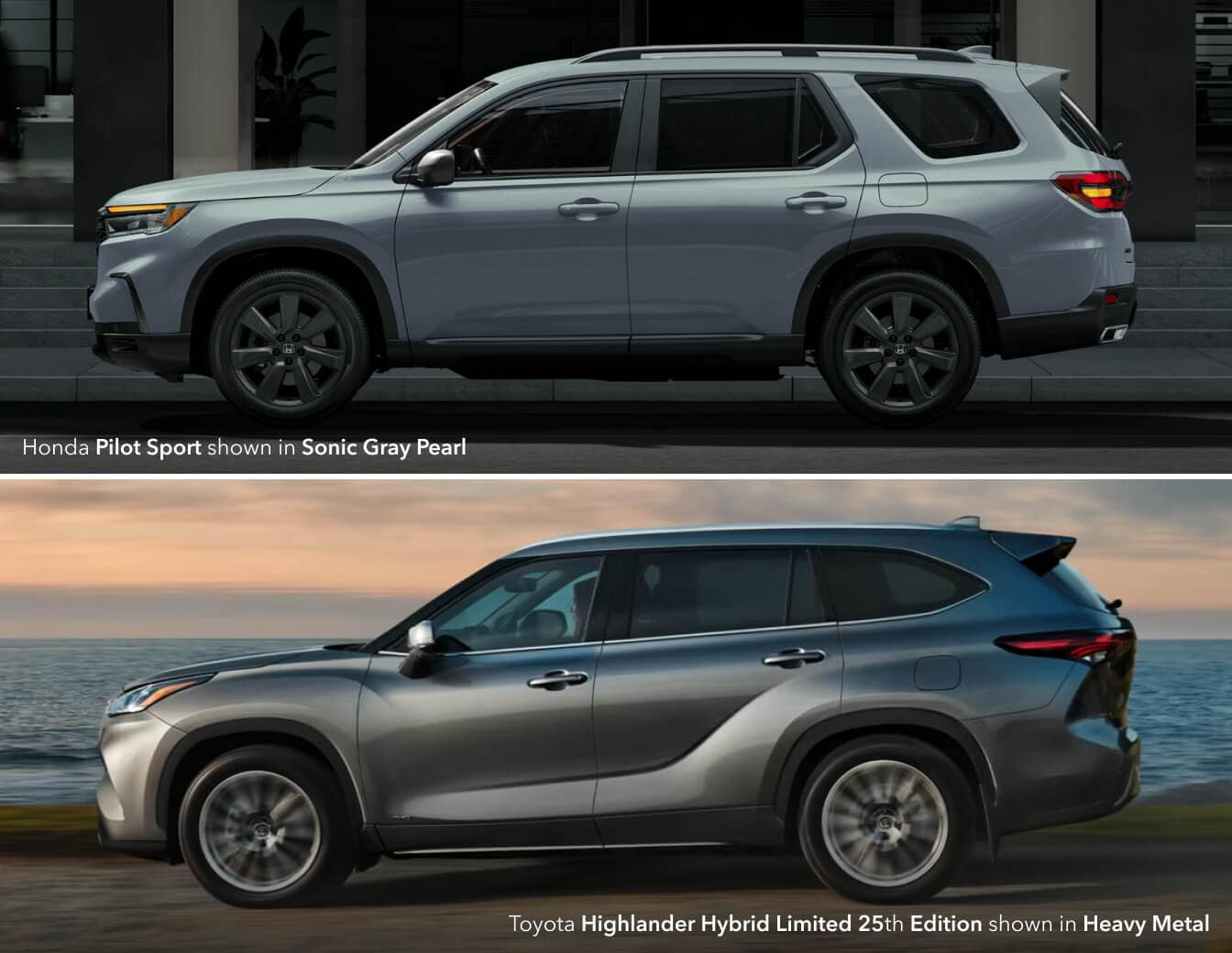
Price & Trims
For shoppers looking for variety and value, the new 2025 Honda Pilot for sale presents more choices at a lower starting price.
- Honda Pilot: Proudly carries eight trim levels, including the off-road-ready TrailSport, making it versatile for everyday driving and outdoor outings.
- Toyota Highlander: Has five gas-powered trim levels, but the options are less adventurous and don't provide the same range as the Pilot.
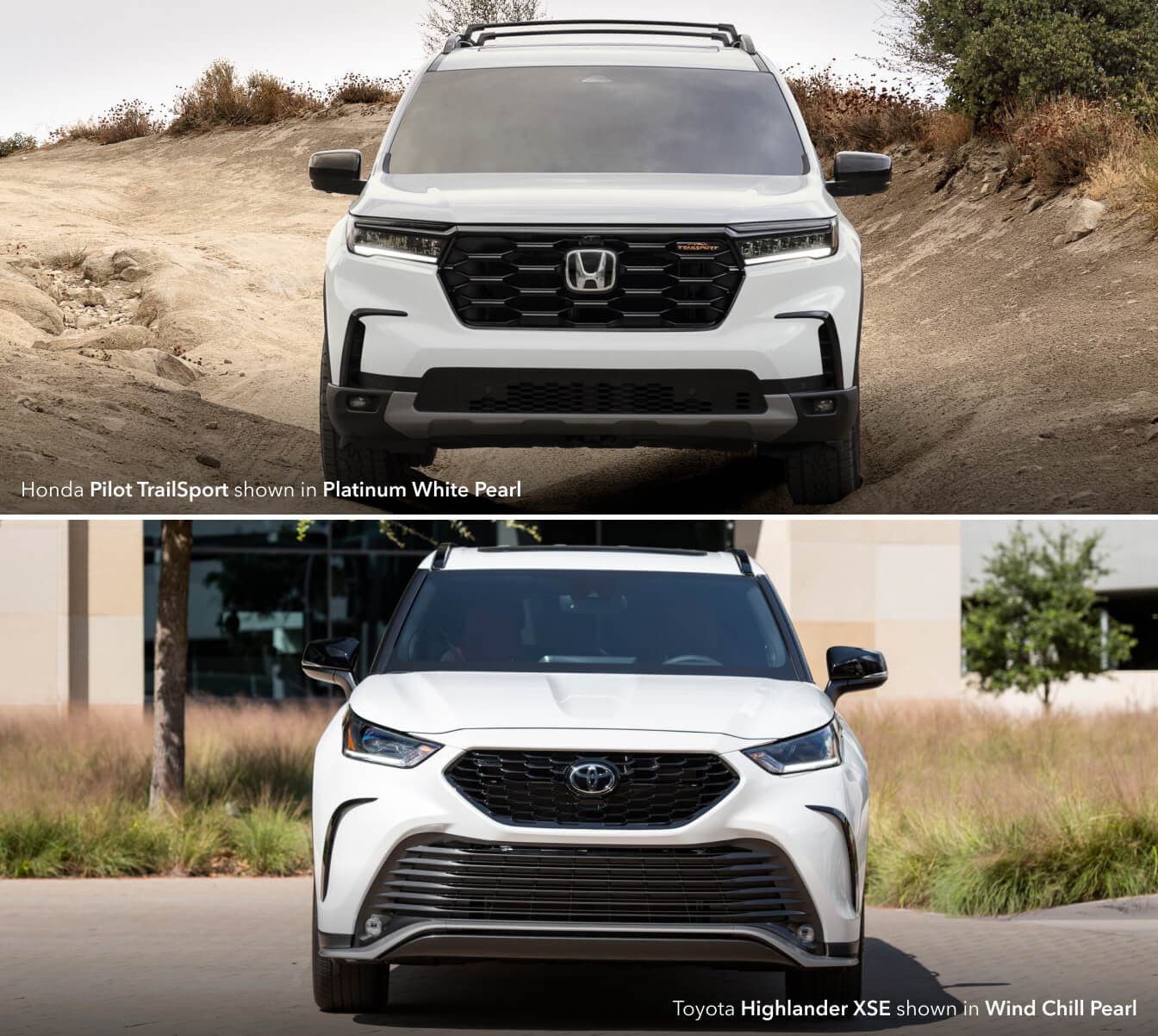
Specs & Performance
The Pilot pulls ahead with higher horsepower, while the Highlander wins in torque. Each can be configured with 2WD or AWD, yet the Pilot provides quicker acceleration for a more responsive ride.
- Honda Pilot: Powered by a robust V-6 engine, the Pilot produces 285 horsepower paired with a smooth-shifting 10-speed automatic transmission, delivering strong pickup and confident performance.
- Toyota Highlander: Fitted with a turbocharged four-cylinder engine, the Highlander harnesses 310 pound-feet of torque, but with lower overall horsepower, it feels less lively compared to the Honda.
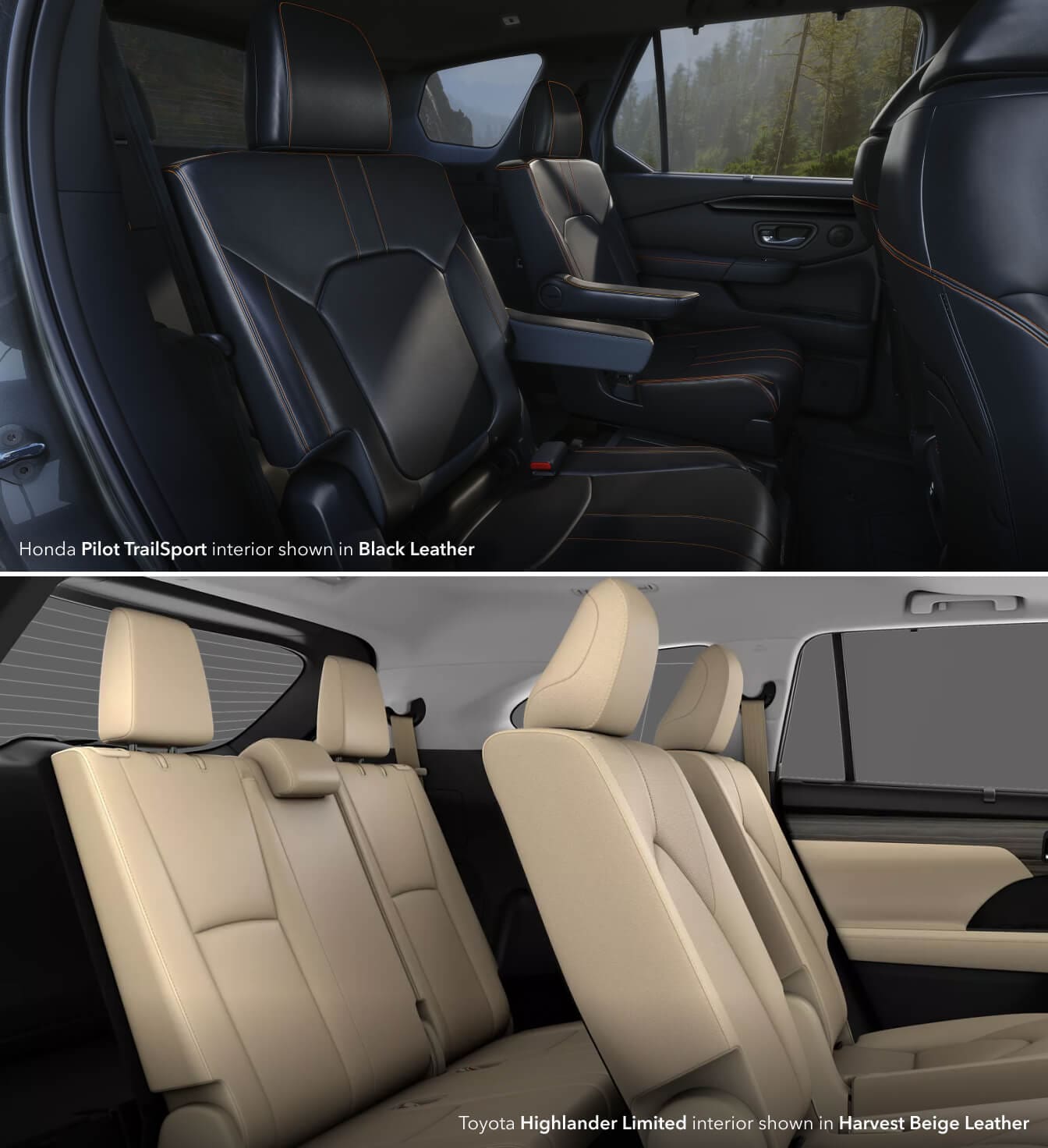
Cargo & Dimensions
The Pilot stands out with more generous passenger and cargo room. Even when comparing Toyota and Honda crossovers, such as in our Toyota RAV4 vs. Honda CR-V review, Honda continues to pull ahead in the storage area.
- Honda Pilot: Provides ample interior space, with 40.2 inches and 39.3 inches of headroom and 40.8 inches and 32.5 inches of legroom in the second and third rows, respectively. It reinforces its size lead with a cargo capacity of 87 cubic feet, a passenger volume of 158.4 cubic feet, and maximum ground clearance of 8.3 inches.
- Toyota Highlander: While more cramped overall, the Highlander provides a bit more front-row space, with 41.2 inches of headroom and 42 inches of legroom. However, its cargo space of 84.3 cubic feet and passenger volume of 141.8 cubic feet are notably less. The max 8-inch ground clearance falls short, too.
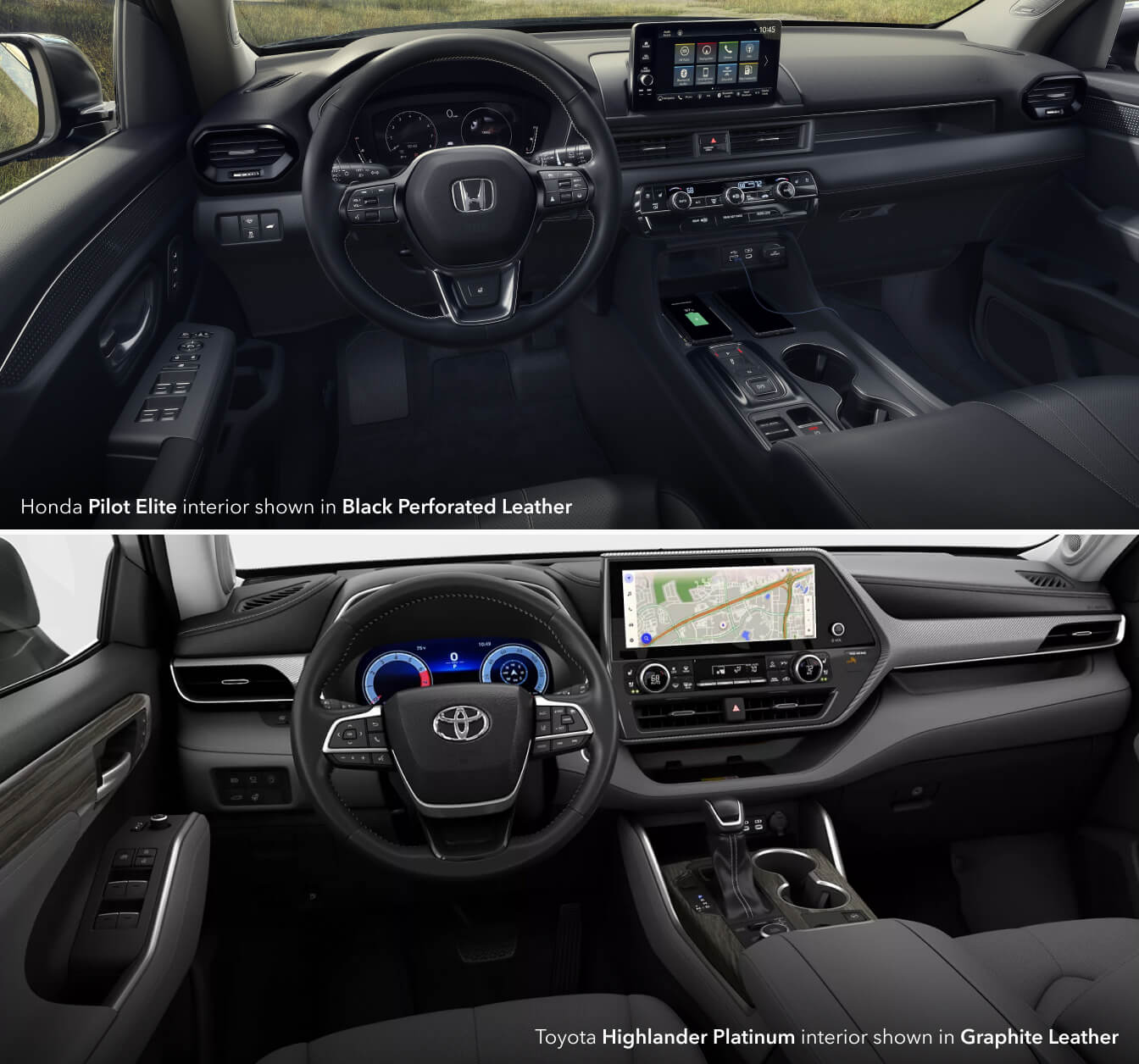
Interior & Technology
Both SUVs come equipped with modern tech and features, including Apple CarPlay® and Android Auto® integration, a three-zone automatic climate control system, and a standard 7-inch information display.
- Honda Pilot: Includes a leather-wrapped steering wheel, driver's seat with 10-way power adjustment, and heated seats. Available upgrades include wireless charging and a 12-speaker Bose® premium sound system.
- Toyota Highlander: Has a leather-wrapped steering wheel and shift knob, a standard 8-inch multimedia system, and available 11-speaker JBL® premium audio and wireless charging.
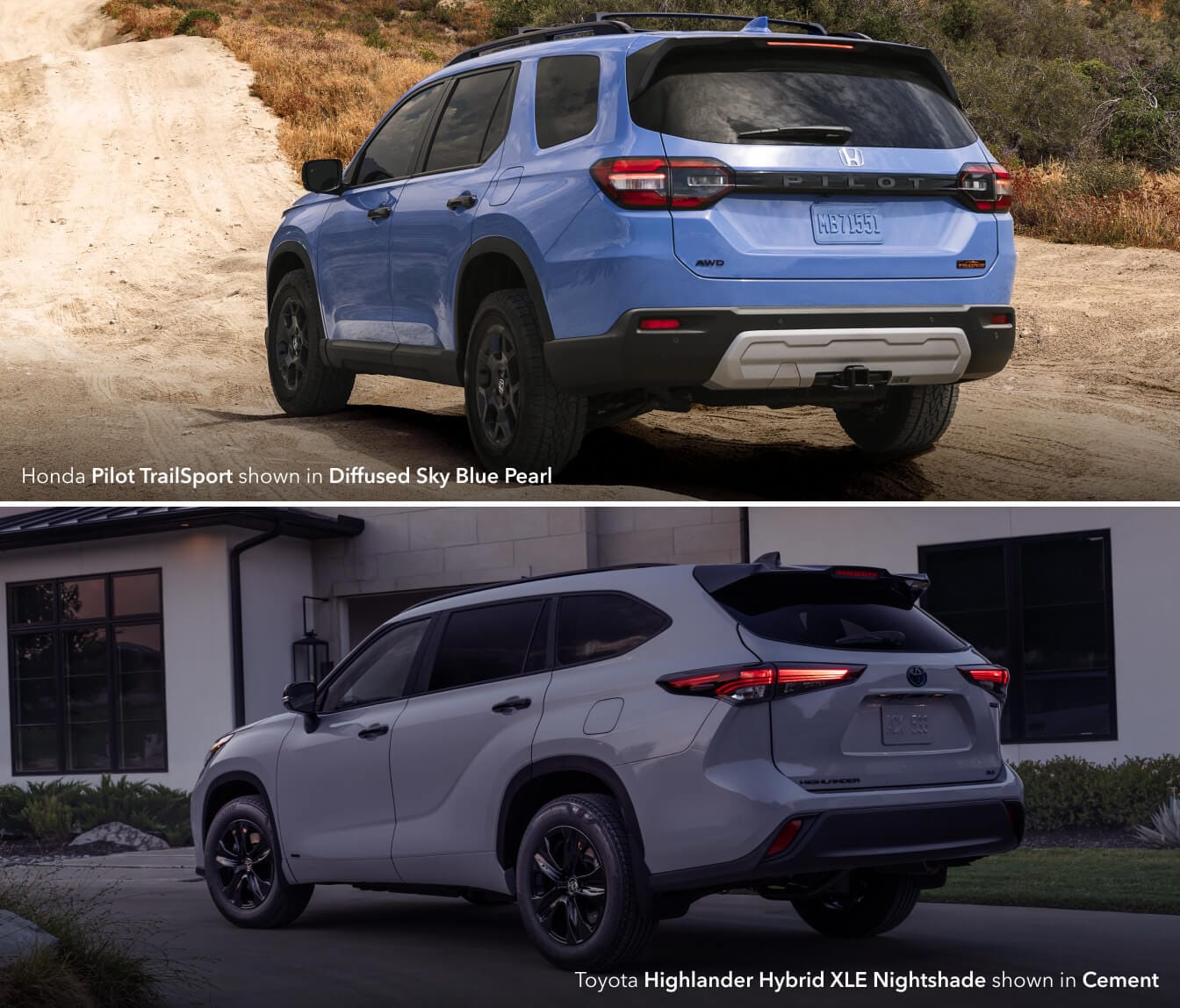
Gas Mileage
While the Highlander edges out the Pilot with slightly higher MPG, the Honda's larger fuel tank helps extend its total driving range, making it a strong contender for longer trips.
- Honda Pilot: Achieves up to an EPA-estimated 19/27 MPG (City/Highway)4 and comes with a larger 18.5-gallon fuel tank, giving it a slight advantage in overall driving range.
- Toyota Highlander: Offers up to an EPA-estimated 22/29 MPG (City/Highway)5, but with a smaller 17.9-gallon fuel tank, which limits its total range.
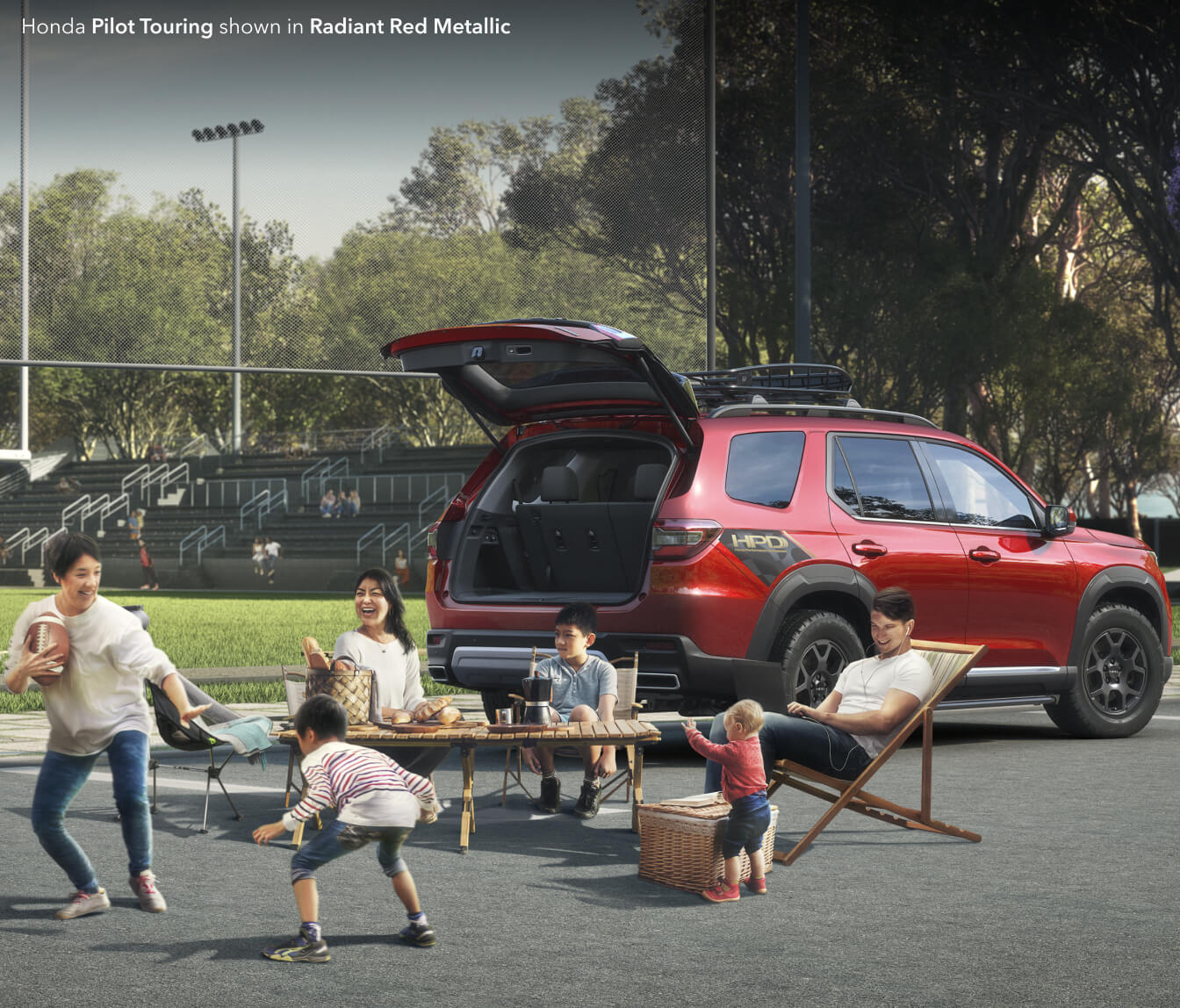
Safety & Reliability
You'll find advanced safety systems and strong reputations for the Pilot and Highlander, but the Honda stands out with higher ratings and notable awards.
- Honda Pilot: Backed by Honda Sensing with standard Blind Spot Monitoring, Adaptive Cruise Control, and Consumer Reports gives the new Pilot a higher overall reliability score than the Highlander.8
- Toyota Highlander: Equipped with Toyota Safety Sense 2.5 with standard Blind Spot Monitoring and Radar Cruise Control, though it lacks some of the top accolades earned by the Pilot in 2025.
Experience the Honda Pilot at Phil Hughes Honda
Our Honda Pilot vs. Toyota Highlander review is clear: The 2025 Pilot is the more well-rounded choice, offering more interior space, versatile cargo volume, roaring performance, and top-tier safety systems, effortlessly shifting from a daily commuter to the ultimate family adventure companion.
Trying to decide between a three-row and a two-row SUV? Check out our Honda Pilot vs. Honda Passport comparison to explore the highlights and benefits of each model.
2025 Honda Pilot Pros & Cons
Pros
- Lower starting MSRP
- Standard V-6 powertrain with higher horsepower
- Robust trim level selection
- Trail-ready model with all-season tires and skid plates
- More max cargo space and passenger volume
Cons
- Lower torque
2025 Toyota Highlander Pros & Cons
Pros
- Higher torque
- Hybrid lineup available
Cons
- Lower horsepower
- No off-road model
- Less cargo space and passenger volume
Frequently Asked Questions
Which has more cargo space: Honda Pilot or Toyota Highlander?
The 2025 Honda Pilot takes the lead in cargo capacity, offering drivers up to 87 cubic feet of maximum cargo space compared to just 84.3 cubic feet in the Toyota Highlander. This extra room makes the Pilot ideal for families, road trips, and hauling larger items, ranging from outdoor gear to sports equipment to groceries to feed the household.
Which is a better family car: Honda Pilot or Toyota Highlander?
While both SUVs seat seven to eight passengers, a closer look shows the 2025 Honda Pilot as the more family-friendly choice. It offers greater headroom and legroom in the second and third rows than the Toyota Highlander, more overall passenger volume at 158.4 cubic feet, and a higher number of trims with standard seating for eight instead of seven.
Which is more reliable: Honda Pilot or Toyota Highlander?
Both Honda and Toyota have strong reputations for producing reliable vehicles. While either midsize SUV can last many years with proper maintenance, Consumer Reports gives the 2025 Honda Pilot a higher overall score than the 2025 Toyota Highlander, with a 79 versus 77 in predicted reliability.8,9 This higher rating reflects the Pilot's consistent performance, durability, and owner satisfaction over time.
Customer Reviews On The Honda Pilot:
1Reference to this third-party claim is solely for informational purposes and not to be relied upon. For details regarding this award, visit https://www.iihs.org
2This information is not verified by the official manufacturer and shall serve solely as unofficial general information. For details, visit: https://www.motortrend.com/cars/honda/pilot
3This information is not verified by the official manufacturer and shall serve solely as unofficial general information. For details, visit: https://www.caranddriver.com/toyota/highlander
4Based on 2025 EPA mileage ratings. Use for comparison purposes only. Your mileage will vary depending on driving conditions, how you drive and maintain your vehicle, and other factors.
5Use for comparison purposes only. Your mileage will vary for many reasons, including your vehicle's condition and how/where you drive. See www.fueleconomy.gov.
6Towing requires accessory towing equipment. Please see your Honda dealer for details.
7Before towing, confirm your vehicle and trailer are compatible, hooked up and loaded properly and that you have any necessary additional equipment. Do not exceed any Weight Ratings and follow all instructions in your Owner's Manual. The maximum you can tow depends on base curb weight plus the total weight of any cargo, occupants, and added vehicle equipment. "Added vehicle equipment" includes additional standard/optional equipment and accessories added by the manufacturer, dealers, and/or vehicle owners. The only way to be certain of your vehicle's exact curb weight is to weigh your vehicle without passengers or cargo. [Calculated with the new SAE J2807 method.] Installation of a tow hitch receiver or other accessories located near the rear bumper or side-door kick sensors may require disabling or removing the kick sensor, and the sensor operation setting in your vehicle should be turned off. See Owner's Manual for limitations.
8Reference to this third-party claim is solely for informational purposes and not to be relied upon. For details regarding this rating, Consumer Reports members can visit https://www.consumerreports.org/cars/honda/pilot/2025/overview/
9Reference to this third-party claim is solely for informational purposes and not to be relied upon. For details regarding this rating, Consumer Reports members can visit https://www.consumerreports.org/cars/toyota/highlander/2025/overview/
10Warranties listed on this web page shall not be solely relied upon. Warranties may be subject to specific terms, restrictions, exclusions, and fees. Additional warranty information may be obtained by visiting the official website of the warranty provider. Contact our dealership for complete details.